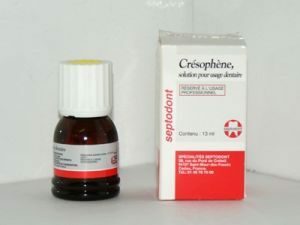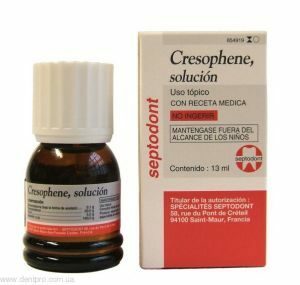 Cresophene is a remedy that is used in dentistry. With its help, the root canals are treated before they are sealed.
Cresophene is a remedy that is used in dentistry. With its help, the root canals are treated before they are sealed.
Available in liquid form in 13 ml vials. There is also a form of release in clinical vials of 45 ml. Country of origin - France.
Composition features and therapeutic effect
Cresofen is a multicomponent agent, with 100 grams of the drug contains:
- dexamethasone acetate - 0.1 g;
- parahlorphenol - 30 g;
- Thymol - 5 g
- Ramsemic camphor - 64 g.
Each of the components has its own properties, the combination of which gives the drug qualities that are useful for effective antimicrobial treatment of the root canals of the tooth, and also cavities that result from caries:
- Dexamethasone refers to glucocorticosteroid hormones. It has well-pronounced anti-inflammatory and
 anti-allergenic properties.
anti-allergenic properties. - Parachlorophenol is a bactericide. Its feature is low surface tension. Due to this property, the substance easily penetrates into the finest microchannels of the root of the tooth. Parachlorophenol is the antiseptic base of the drug.
- Timol is a natural phenol found in thyme and a number of other plants. It also has pronounced antimicrobial and antifungal properties.
- Racemic camphor in the composition is designed to mitigate the effect of phenols on the body. It also has analgesic, antimicrobial and anti-inflammatory properties.
Manufacturers of Cresofena position it as a remedy that does not have an irritant effect. Unlike other similar drugs, it can be used together with antibiotics. It is also emphasized that it does not contain arsenic, which means it can be used in the treatment of pregnant women and breast-feeding women.
Features of the application
Dentists use this tool in the treatment of deep caries, in the case of incomplete removal of the nerve, with poor patency of the root canals, as well as with periodontitis.
In the treatment of deep caries, Cresophene is used in the formulation of Evgenat, with the help of which a carious cavity is sterilized. For this, a drop of the drug is mixed with Eugenol and zinc oxide.
 Use the medication and after pulp extirpation. For this purpose, one drop of the substance is placed in the root canal and left there for several minutes. Then the remnants of the drug are removed with the help of turunda and it is possible to start filling.
Use the medication and after pulp extirpation. For this purpose, one drop of the substance is placed in the root canal and left there for several minutes. Then the remnants of the drug are removed with the help of turunda and it is possible to start filling.
With periodontitis, the infected pulp is first removed. Root canals expand and dry. After that, antiseptic is impregnated with turunda and placed in a canal.
The minimum duration of the drug in the canal is 3 days. At this time, it is isolated from the external environment by means of a hermetically sealed bandage. In the event that once the sterility of the canal was not achieved, the treatment is repeated once more. And only after this you can put a permanent seal.
When using a medicament, the physician should:
- prevent possible ingestion of the drug to patients;
- avoid excessive impregnation with a cotton swab;
- do not use it on open pulp.
Price of the issue
Among other similar preparations, Cresofen is distinguished by a high price, so dentists often use its analogues in their practice.
One such means is the Russian drug Cresodent, the cost of which is several times lower. In addition, such agents as Cresolate, Conceptis and others can be used.
